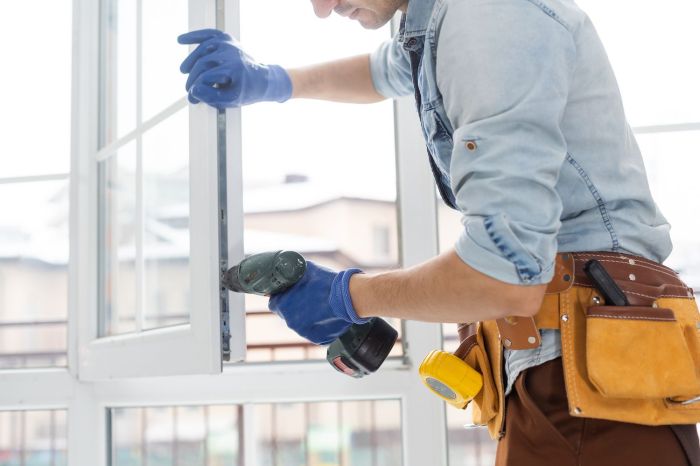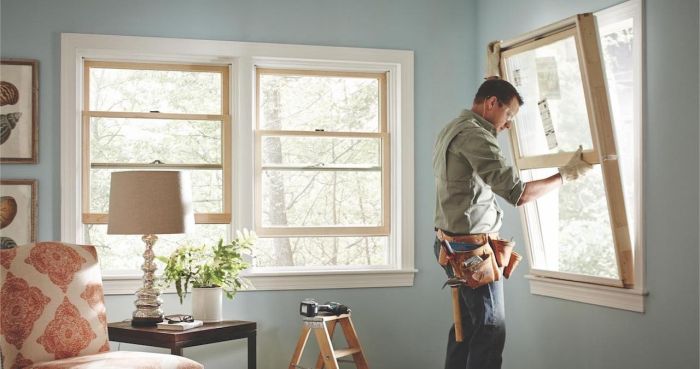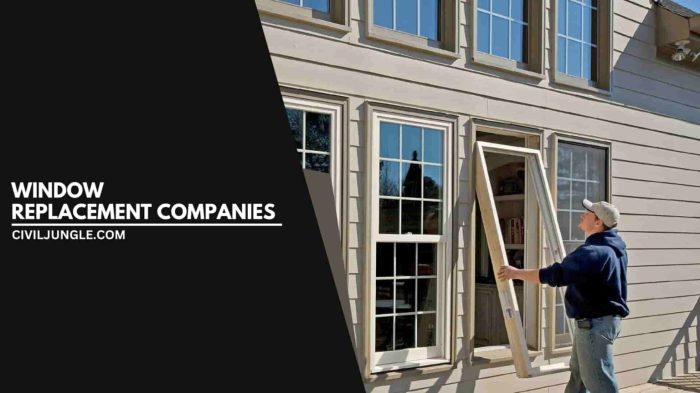Exploring the world of replacement window companies unveils a myriad of options and considerations that can significantly impact your home. From the different types of replacement windows to crucial factors to consider, this guide aims to provide a holistic view of what to expect when embarking on this journey.
As we delve deeper into the realm of replacement window companies, you'll discover valuable insights that will empower you to make informed decisions for your home improvement project.
Types of Replacement Windows

When it comes to replacement windows, there are several types available in the market, each with its own set of benefits and features. The most common types include vinyl, wood, fiberglass, and aluminum replacement windows. Let's explore the differences between them and understand their unique qualities.
Vinyl Replacement Windows
Vinyl replacement windows are known for their affordability, low maintenance, and energy efficiency. They are made of PVC (polyvinyl chloride) material, which is durable and resistant to rotting, fading, and warping. These windows are also excellent insulators, helping to reduce energy costs and noise transmission.
Wood Replacement Windows
Wood replacement windows offer a classic and timeless look to any home. They are highly customizable, allowing for various finishes and designs. Wood windows provide excellent insulation but require more maintenance compared to other materials. Regular painting or staining is necessary to protect the wood from moisture and weather damage.
Fiberglass Replacement Windows
Fiberglass replacement windows are gaining popularity due to their durability and strength. They are resistant to expansion and contraction, making them ideal for extreme weather conditions. Fiberglass windows offer excellent thermal performance and can mimic the look of traditional wood windows without the maintenance requirements.
Aluminum Replacement Windows
Aluminum replacement windows are known for their slim profiles and modern aesthetic. They are lightweight, strong, and resistant to corrosion, making them ideal for coastal areas. However, aluminum windows are not as energy-efficient as other materials and can contribute to heat loss or gain if not properly insulated.
Energy Efficiency: Double-pane vs. Triple-pane Windows
When it comes to energy efficiency, the number of panes in a window plays a crucial role. Double-pane windows have two layers of glass with a space filled with gas in between, providing better insulation than single-pane windows. On the other hand, triple-pane windows have three layers of glass and offer even higher energy efficiency and sound insulation.
While triple-pane windows are more expensive upfront, they can help reduce heating and cooling costs in the long run.
Factors to Consider When Choosing a Replacement Window Company

When selecting a replacement window company, there are several crucial factors to consider to ensure you make the right choice for your home.
Reputation and Experience
One of the key factors to consider is the reputation and experience of the replacement window company. Look for companies with a solid track record of satisfied customers and years of experience in the industry.
Warranties and Certifications
It is important to choose a company that offers strong warranties on their products and installation services. Additionally, certifications from reputable organizations can indicate the company's commitment to quality and professionalism.
Energy Efficiency Ratings
When choosing replacement windows, pay attention to energy efficiency ratings such as the U-Factor and Solar Heat Gain Coefficient. These ratings can help you select windows that will improve your home's energy efficiency and reduce utility costs.
Proper Installation and After-Sales Service
Proper installation is key to ensuring your replacement windows perform as intended. Choose a company that offers professional installation services and reliable after-sales support to address any issues that may arise after the installation.
Cost Considerations
When it comes to replacing windows in your home, cost is a significant factor to consider. The total cost of window replacement can vary depending on several factors, including the material of the windows, their size, and any additional features or upgrades you choose.
Typical Cost Range
The typical cost range for replacing windows in a standard home can fall anywhere between $300 to $1,000 per window. This cost range can increase based on the type of material you choose for your windows, such as vinyl, wood, aluminum, or fiberglass.
Factors Impacting Cost
- Window Material: Different materials come at different price points, with wood generally being the most expensive and vinyl being more budget-friendly.
- Window Size: Larger windows or custom-sized windows will typically cost more to replace compared to standard-sized windows.
- Additional Features: Upgrades like energy-efficient glass, double or triple-pane windows, or decorative elements can add to the overall cost.
Getting Accurate Quotes
- Get Multiple Quotes: Reach out to several replacement window companies to get a range of quotes to compare.
- Be Specific: Provide precise details about the type of windows you want, including material, size, and any additional features, to receive accurate quotes.
- Avoid Hidden Costs: Make sure the quotes you receive include all costs, such as installation, labor, and any potential additional charges.
Installation Process
When it comes to installing replacement windows, there are several crucial steps involved to ensure a successful and efficient process.
Proper Measurements and Preparations
Before beginning the installation of replacement windows, it is imperative to take accurate measurements of the window openings. Proper measurements ensure that the new windows will fit correctly and function optimally. Additionally, thorough preparations such as clearing the work area, removing old windows, and addressing any structural issues are essential to a smooth installation process.
Step-by-Step Process
- Remove old windows: The first step is to carefully remove the existing windows, taking care to avoid damage to the surrounding areas.
- Clean and prepare the window opening: The window opening should be cleaned thoroughly and any repairs or adjustments should be made to ensure a proper fit for the new window.
- Install the new window: The replacement window is then carefully placed into the opening, ensuring a snug and secure fit.
- Secure the window: The window is securely fastened in place using appropriate screws or nails to prevent any movement or drafts.
- Insulate and seal: To improve energy efficiency, insulation is added around the window frame, and a sealant is applied to prevent air leaks.
- Finish the interior and exterior: Any necessary trim work or caulking is done to complete the installation and ensure a clean and professional appearance.
Common Challenges
- Uneven window openings: Inaccurate measurements or structural issues can lead to uneven window openings, making it difficult to install replacement windows properly.
- Weather conditions: Harsh weather conditions can impact the installation process, causing delays or complications.
- Structural damage: Discovering structural damage during the installation process may require additional repairs or modifications to ensure the new windows are properly installed.
Final Wrap-Up

In conclusion, navigating the realm of replacement window companies requires attention to detail and a keen eye for quality. By considering the factors discussed and armed with the knowledge provided, you are well-equipped to embark on this transformative journey for your home.
Question & Answer Hub
What factors should I consider when choosing a replacement window company?
Factors to consider include reputation, experience, warranties, certifications, and energy efficiency ratings.
What is the typical cost range for replacing windows in a standard home?
The cost can vary but typically ranges from $300 to $1,000 per window.
What are common challenges during the installation of replacement windows?
Common challenges include proper measurements, preparations, and potential issues with fit during installation.










